Heng Li
SPATIALGEN: Layout-guided 3D Indoor Scene Generation
Sep 18, 2025Abstract:Creating high-fidelity 3D models of indoor environments is essential for applications in design, virtual reality, and robotics. However, manual 3D modeling remains time-consuming and labor-intensive. While recent advances in generative AI have enabled automated scene synthesis, existing methods often face challenges in balancing visual quality, diversity, semantic consistency, and user control. A major bottleneck is the lack of a large-scale, high-quality dataset tailored to this task. To address this gap, we introduce a comprehensive synthetic dataset, featuring 12,328 structured annotated scenes with 57,440 rooms, and 4.7M photorealistic 2D renderings. Leveraging this dataset, we present SpatialGen, a novel multi-view multi-modal diffusion model that generates realistic and semantically consistent 3D indoor scenes. Given a 3D layout and a reference image (derived from a text prompt), our model synthesizes appearance (color image), geometry (scene coordinate map), and semantic (semantic segmentation map) from arbitrary viewpoints, while preserving spatial consistency across modalities. SpatialGen consistently generates superior results to previous methods in our experiments. We are open-sourcing our data and models to empower the community and advance the field of indoor scene understanding and generation.
SAIL-Recon: Large SfM by Augmenting Scene Regression with Localization
Aug 25, 2025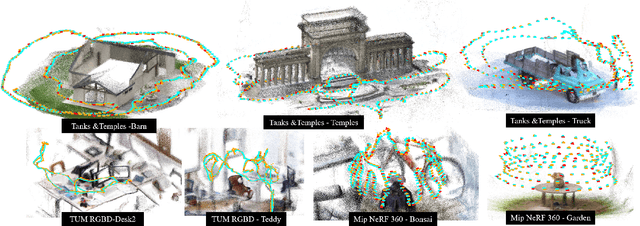
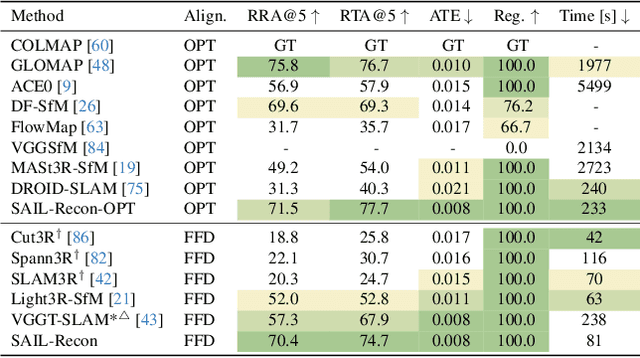
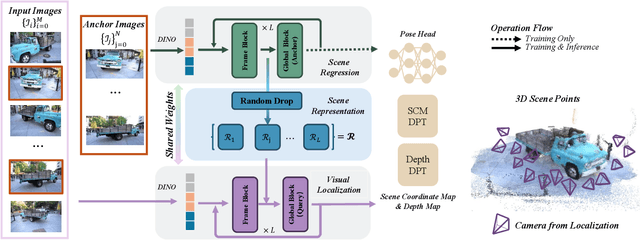

Abstract:Scene regression methods, such as VGGT, solve the Structure-from-Motion (SfM) problem by directly regressing camera poses and 3D scene structures from input images. They demonstrate impressive performance in handling images under extreme viewpoint changes. However, these methods struggle to handle a large number of input images. To address this problem, we introduce SAIL-Recon, a feed-forward Transformer for large scale SfM, by augmenting the scene regression network with visual localization capabilities. Specifically, our method first computes a neural scene representation from a subset of anchor images. The regression network is then fine-tuned to reconstruct all input images conditioned on this neural scene representation. Comprehensive experiments show that our method not only scales efficiently to large-scale scenes, but also achieves state-of-the-art results on both camera pose estimation and novel view synthesis benchmarks, including TUM-RGBD, CO3Dv2, and Tanks & Temples. We will publish our model and code. Code and models are publicly available at: https://hkust-sail.github.io/ sail-recon/.
Endoscopic Depth Estimation Based on Deep Learning: A Survey
Jul 28, 2025Abstract:Endoscopic depth estimation is a critical technology for improving the safety and precision of minimally invasive surgery. It has attracted considerable attention from researchers in medical imaging, computer vision, and robotics. Over the past decade, a large number of methods have been developed. Despite the existence of several related surveys, a comprehensive overview focusing on recent deep learning-based techniques is still limited. This paper endeavors to bridge this gap by systematically reviewing the state-of-the-art literature. Specifically, we provide a thorough survey of the field from three key perspectives: data, methods, and applications, covering a range of methods including both monocular and stereo approaches. We describe common performance evaluation metrics and summarize publicly available datasets. Furthermore, this review analyzes the specific challenges of endoscopic scenes and categorizes representative techniques based on their supervision strategies and network architectures. The application of endoscopic depth estimation in the important area of robot-assisted surgery is also reviewed. Finally, we outline potential directions for future research, such as domain adaptation, real-time implementation, and enhanced model generalization, thereby providing a valuable starting point for researchers to engage with and advance the field.
PanTS: The Pancreatic Tumor Segmentation Dataset
Jul 02, 2025Abstract:PanTS is a large-scale, multi-institutional dataset curated to advance research in pancreatic CT analysis. It contains 36,390 CT scans from 145 medical centers, with expert-validated, voxel-wise annotations of over 993,000 anatomical structures, covering pancreatic tumors, pancreas head, body, and tail, and 24 surrounding anatomical structures such as vascular/skeletal structures and abdominal/thoracic organs. Each scan includes metadata such as patient age, sex, diagnosis, contrast phase, in-plane spacing, slice thickness, etc. AI models trained on PanTS achieve significantly better performance in pancreatic tumor detection, localization, and segmentation compared to those trained on existing public datasets. Our analysis indicates that these gains are directly attributable to the 16x larger-scale tumor annotations and indirectly supported by the 24 additional surrounding anatomical structures. As the largest and most comprehensive resource of its kind, PanTS offers a new benchmark for developing and evaluating AI models in pancreatic CT analysis.
Unleashing Diffusion and State Space Models for Medical Image Segmentation
Jun 15, 2025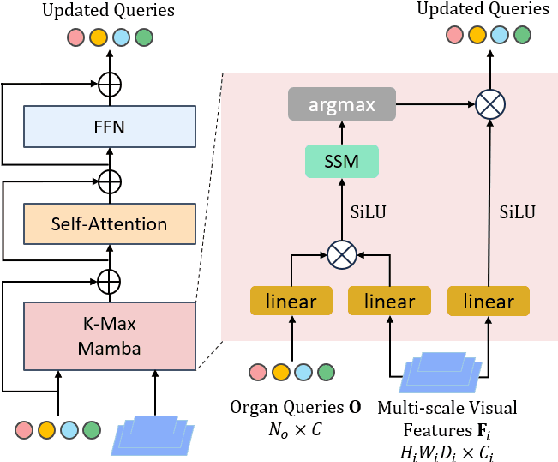
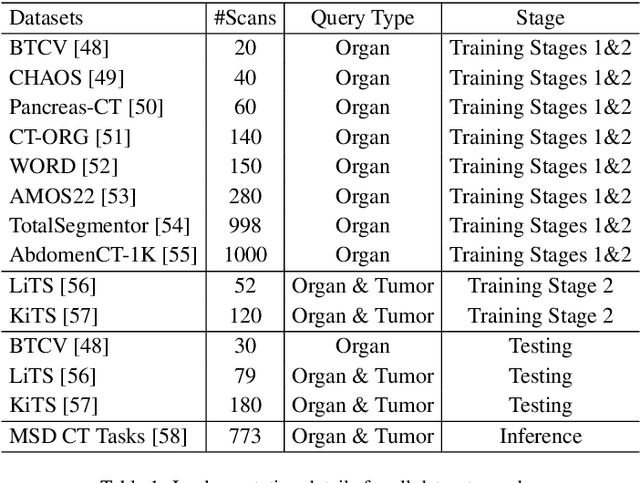
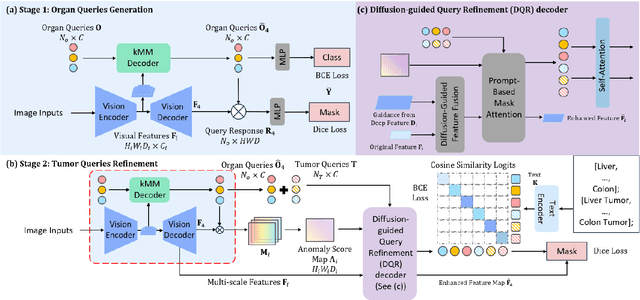

Abstract:Existing segmentation models trained on a single medical imaging dataset often lack robustness when encountering unseen organs or tumors. Developing a robust model capable of identifying rare or novel tumor categories not present during training is crucial for advancing medical imaging applications. We propose DSM, a novel framework that leverages diffusion and state space models to segment unseen tumor categories beyond the training data. DSM utilizes two sets of object queries trained within modified attention decoders to enhance classification accuracy. Initially, the model learns organ queries using an object-aware feature grouping strategy to capture organ-level visual features. It then refines tumor queries by focusing on diffusion-based visual prompts, enabling precise segmentation of previously unseen tumors. Furthermore, we incorporate diffusion-guided feature fusion to improve semantic segmentation performance. By integrating CLIP text embeddings, DSM captures category-sensitive classes to improve linguistic transfer knowledge, thereby enhancing the model's robustness across diverse scenarios and multi-label tasks. Extensive experiments demonstrate the superior performance of DSM in various tumor segmentation tasks. Code is available at https://github.com/Rows21/KMax-Mamba.
SeePhys: Does Seeing Help Thinking? -- Benchmarking Vision-Based Physics Reasoning
May 25, 2025Abstract:We present SeePhys, a large-scale multimodal benchmark for LLM reasoning grounded in physics questions ranging from middle school to PhD qualifying exams. The benchmark covers 7 fundamental domains spanning the physics discipline, incorporating 21 categories of highly heterogeneous diagrams. In contrast to prior works where visual elements mainly serve auxiliary purposes, our benchmark features a substantial proportion of vision-essential problems (75\%) that mandate visual information extraction for correct solutions. Through extensive evaluation, we observe that even the most advanced visual reasoning models (e.g., Gemini-2.5-pro and o4-mini) achieve sub-60\% accuracy on our benchmark. These results reveal fundamental challenges in current large language models' visual understanding capabilities, particularly in: (i) establishing rigorous coupling between diagram interpretation and physics reasoning, and (ii) overcoming their persistent reliance on textual cues as cognitive shortcuts.
SDLog: A Deep Learning Framework for Detecting Sensitive Information in Software Logs
May 20, 2025Abstract:Software logs are messages recorded during the execution of a software system that provide crucial run-time information about events and activities. Although software logs have a critical role in software maintenance and operation tasks, publicly accessible log datasets remain limited, hindering advance in log analysis research and practices. The presence of sensitive information, particularly Personally Identifiable Information (PII) and quasi-identifiers, introduces serious privacy and re-identification risks, discouraging the publishing and sharing of real-world logs. In practice, log anonymization techniques primarily rely on regular expression patterns, which involve manually crafting rules to identify and replace sensitive information. However, these regex-based approaches suffer from significant limitations, such as extensive manual efforts and poor generalizability across diverse log formats and datasets. To mitigate these limitations, we introduce SDLog, a deep learning-based framework designed to identify sensitive information in software logs. Our results show that SDLog overcomes regex limitations and outperforms the best-performing regex patterns in identifying sensitive information. With only 100 fine-tuning samples from the target dataset, SDLog can correctly identify 99.5% of sensitive attributes and achieves an F1-score of 98.4%. To the best of our knowledge, this is the first deep learning alternative to regex-based methods in software log anonymization.
RADAR: Enhancing Radiology Report Generation with Supplementary Knowledge Injection
May 20, 2025Abstract:Large language models (LLMs) have demonstrated remarkable capabilities in various domains, including radiology report generation. Previous approaches have attempted to utilize multimodal LLMs for this task, enhancing their performance through the integration of domain-specific knowledge retrieval. However, these approaches often overlook the knowledge already embedded within the LLMs, leading to redundant information integration and inefficient utilization of learned representations. To address this limitation, we propose RADAR, a framework for enhancing radiology report generation with supplementary knowledge injection. RADAR improves report generation by systematically leveraging both the internal knowledge of an LLM and externally retrieved information. Specifically, it first extracts the model's acquired knowledge that aligns with expert image-based classification outputs. It then retrieves relevant supplementary knowledge to further enrich this information. Finally, by aggregating both sources, RADAR generates more accurate and informative radiology reports. Extensive experiments on MIMIC-CXR, CheXpert-Plus, and IU X-ray demonstrate that our model outperforms state-of-the-art LLMs in both language quality and clinical accuracy
Document Image Rectification Bases on Self-Adaptive Multitask Fusion
May 09, 2025Abstract:Deformed document image rectification is essential for real-world document understanding tasks, such as layout analysis and text recognition. However, current multi-task methods -- such as background removal, 3D coordinate prediction, and text line segmentation -- often overlook the complementary features between tasks and their interactions. To address this gap, we propose a self-adaptive learnable multi-task fusion rectification network named SalmRec. This network incorporates an inter-task feature aggregation module that adaptively improves the perception of geometric distortions, enhances feature complementarity, and reduces negative interference. We also introduce a gating mechanism to balance features both within global tasks and between local tasks effectively. Experimental results on two English benchmarks (DIR300 and DocUNet) and one Chinese benchmark (DocReal) demonstrate that our method significantly improves rectification performance. Ablation studies further highlight the positive impact of different tasks on dewarping and the effectiveness of our proposed module.
STDArm: Transferring Visuomotor Policies From Static Data Training to Dynamic Robot Manipulation
Apr 26, 2025Abstract:Recent advances in mobile robotic platforms like quadruped robots and drones have spurred a demand for deploying visuomotor policies in increasingly dynamic environments. However, the collection of high-quality training data, the impact of platform motion and processing delays, and limited onboard computing resources pose significant barriers to existing solutions. In this work, we present STDArm, a system that directly transfers policies trained under static conditions to dynamic platforms without extensive modifications. The core of STDArm is a real-time action correction framework consisting of: (1) an action manager to boost control frequency and maintain temporal consistency, (2) a stabilizer with a lightweight prediction network to compensate for motion disturbances, and (3) an online latency estimation module for calibrating system parameters. In this way, STDArm achieves centimeter-level precision in mobile manipulation tasks. We conduct comprehensive evaluations of the proposed STDArm on two types of robotic arms, four types of mobile platforms, and three tasks. Experimental results indicate that the STDArm enables real-time compensation for platform motion disturbances while preserving the original policy's manipulation capabilities, achieving centimeter-level operational precision during robot motion.
 Add to Chrome
Add to Chrome Add to Firefox
Add to Firefox Add to Edge
Add to Edge